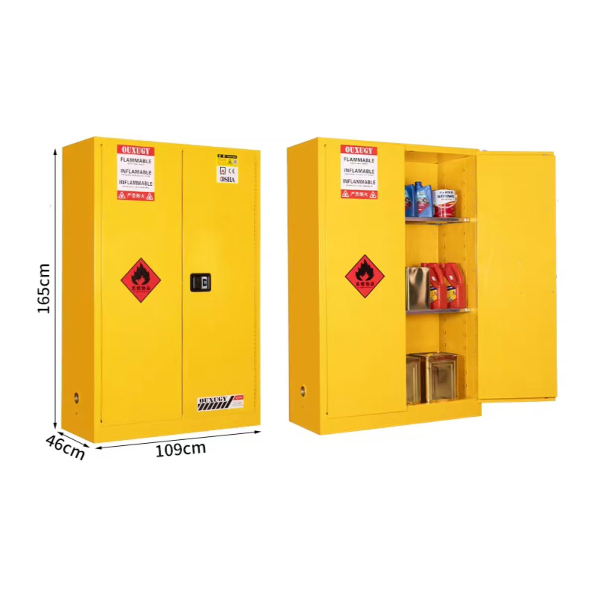When it comes to safely storing hazardous materials, specifically flammable liquids, the National Fire Protection Association (NFPA) has established critical guidelines to ensure safety in both industrial and laboratory settings. These guidelines, outlined in the NFPA 30 “Flammable and Combustible Liquids Code,” provide a clear framework for the proper use and storage of flammable liquids.
As an expert in flammable storage cabinets with extensive knowledge of American safety standards, I’m here to help you understand the essential NFPA requirements and how they impact your facility’s compliance and safety.
Table of Contents
What Are Flammable Storage Cabinets?
Flammable storage cabinets are specialized cabinets designed to safely store flammable liquids. These liquids are highly volatile and pose significant fire hazards if not stored properly. A flammable storage cabinet’s primary function is to reduce the risk of ignition by isolating the contents and providing a layer of fire resistance. While they are not fireproof, these cabinets significantly delay the spread of fire and protect their contents in the event of an emergency.
Key NFPA Requirements for Flammable Storage Cabinets
The NFPA sets specific requirements to ensure the safe handling and storage of flammable liquids. For facilities using or storing such materials, it is crucial to adhere to the following guidelines:
Cabinet Construction
The NFPA specifies that flammable storage cabinets must be constructed from certain materials to meet fire resistance standards. According to NFPA 30, cabinets should be made of steel (at least 18-gauge thick) or another suitable material, such as wood with a specific thickness and fire-resistant coating. The cabinets must have a double wall with at least 1.5 inches of airspace between the walls, which provides additional insulation in the event of a fire.
Labeling
Each flammable storage cabinet must be clearly labeled with the words “Flammable – Keep Fire Away.” The label should be highly visible, typically in red lettering on a yellow background, and placed on the exterior of the cabinet door. This ensures that anyone handling or working around the cabinet is aware of its contents.
Ventilation
The NFPA does not require flammable storage cabinets to be vented; however, if a facility chooses to vent them, it must comply with specific ventilation regulations. The cabinet must be vented outdoors using proper ducts, and the venting must not compromise the fire protection properties of the cabinet. If unvented, the cabinet’s vent openings must remain sealed with bungs that meet the cabinet manufacturer’s specifications.
Storage Limits
The NFPA imposes strict limits on the quantity of flammable liquids that can be stored within a single cabinet. According to NFPA 30, a standard flammable storage cabinet can hold up to 120 gallons of Class I, II, or III liquids combined. However, the amount may vary based on the specific hazard classifications of the stored chemicals. Additionally, no more than three cabinets can be located in a single fire area unless additional fire protection measures are in place.
Location and Placement
Flammable storage cabinets must be strategically located to minimize fire risk. NFPA 30 states that these cabinets should not obstruct hallways or exit routes. Additionally, they should be placed in areas where they are least likely to be exposed to potential ignition sources, such as electrical panels, heat-generating equipment, or open flames.
Doors and Latching
All cabinet doors must be equipped with a three-point latch system. The doors should close securely to contain the contents in case of fire. Additionally, self-closing doors, though not always required by the NFPA, provide extra safety in the event of a fire. Some local jurisdictions may mandate self-closing mechanisms as part of their building or fire codes.
Why NFPA Compliance Matters
Ensuring that your facility complies with NFPA 30 is not only about avoiding fines and penalties; it’s about protecting your employees, property, and the environment from the dangers posed by improper storage of flammable liquids. Non-compliance can lead to disastrous fires, chemical spills, and even explosions. Beyond safety, meeting NFPA standards demonstrates your commitment to responsible operations, which can enhance your company’s reputation and trust within the industry.
How to Ensure NFPA Compliance in Your Facility
To ensure your facility complies with NFPA requirements for flammable storage cabinets, follow these steps:
Purchase Cabinets from Trusted Manufacturers: When selecting a flammable storage cabinet, make sure it meets all the NFPA requirements for construction, capacity, and labeling. Many manufacturers specifically design their cabinets to comply with NFPA 30 and other relevant safety standards, such as OSHA and FM Global.
Regularly Inspect and Maintain Cabinets: NFPA compliance doesn’t stop at purchasing the right equipment. Regularly inspecting and maintaining your cabinets is crucial to ensuring their ongoing effectiveness. Check for any wear and tear, and ensure the cabinet doors, latches, and labels are in good condition.
Properly Train Employees: Make sure all employees who handle flammable liquids are properly trained on safe storage practices. This includes understanding the maximum allowable storage limits, recognizing hazard classifications, and knowing how to properly use and maintain the cabinets.
Conclusion
Adhering to the NFPA 30 requirements for flammable storage cabinets is essential for maintaining a safe and compliant workplace. By investing in high-quality cabinets, strategically placing them in your facility, and ensuring regular inspections, you reduce the risks associated with flammable liquid storage. For businesses handling these materials, following the NFPA guidelines is not just a legal obligation but a critical step toward fostering a safe and secure work environment.
By staying compliant with NFPA standards, you demonstrate a proactive approach to workplace safety, and that’s a decision your employees, customers, and stakeholders can stand behind.




